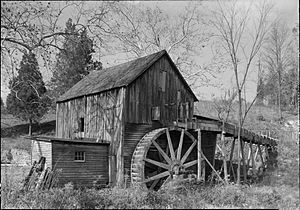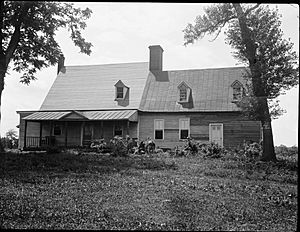Hope Park facts for kids
Quick facts for kids Hope Park and Hope Park Mill |
|
|---|---|
|
Hope Park Plantation
|
|
| General information | |
| Type | Private home and business |
| Location | Fairfax County, Virginia |
| Town or city | Fairfax |
| Country | United States |
| Current tenants |
|
| Owner | Hope Park Plantation
Hope Park Mansion
Hope Park Mill/Miller's House
|
Hope Park was a large farm, known as a plantation, in Fairfax County, Virginia. It was active during the 1700s and 1800s. Hope Park was the home of Dr. David Stuart (1753–1814). He was a close friend of George Washington, America's first president. Dr. Stuart was also the second husband of Eleanor Calvert Custis (1758–1811). She was George Washington's stepdaughter-in-law. Hope Park Plantation was located about 5 miles southwest of Fairfax.
Contents
The Story of Hope Park
The Payne Family Starts Hope Park
The Hope Park plantation began in the 1750s. It was started by Edward Payne. He was a judge in Fairfax County from 1764 to 1785. Payne also built Payne's Church, which was finished in 1778.
Edward Payne worked with George Washington and George Mason on local church matters. George Washington sometimes stayed with the Paynes at Hope Park. Payne also built a small mill on Piney Branch, a stream on the Hope Park land. A mill was very important for a plantation. It helped process crops.
The Stuart Family and Hope Park
Dr. David Stuart bought Hope Park plantation in 1785. Dr. Stuart was a doctor from Alexandria. In 1791, President Washington chose him to be a commissioner for the new Federal City. This city later became Washington, D.C.. Stuart also served as a judge in Fairfax County in 1789.
Dr. Stuart married Eleanor Calvert Custis in 1783. She was the widow of John Parke Custis. John was the son of Martha Washington and stepson of George Washington. The Stuarts lived at Abingdon plantation first. Then, between 1791 and 1793, they moved to Hope Park.
The Stuarts often welcomed George and Martha Washington as guests at Hope Park. The Washingtons also visited the Stuarts at Abingdon. Because of their close friendship, Hope Park is mentioned many times in George Washington's writings.
Important Weddings at Hope Park
Two of Dr. Stuart's stepdaughters were married at Hope Park. They were also George Washington's step-granddaughters.
- Martha Parke Custis married Thomas Peter on January 6, 1795.
- Elizabeth Parke Custis married Thomas Law on March 20, 1796.
These older Custis daughters lived at Hope Park with their mother and stepfather. The younger Custis children, Eleanor and George Washington Parke Custis, visited Hope Park often. They mostly lived with George and Martha Washington at Mount Vernon.
The Second Mill at Hope Park
Most likely, a second mill was built at Hope Park while Dr. Stuart owned it. This happened before the Stuarts moved to Ossian Hall in 1804. This mill was on the west side of Piney Branch. A house for the miller (the person who ran the mill) was also built nearby.
We don't know the exact dates these buildings were made. But in 1815, after Dr. Stuart died, the mill was described as "in complete repair." A study in 1972 suggested the mill was built around 1800. This mill became known as "Hope Park Mill." It was important for grinding grain for nearby farms.
The Barnes Family and Hope Park
Most of the Hope Park land stayed with Dr. Stuart's family until 1837. Then, John H. Barnes, Sr. bought a large piece of land. This included the mill and the miller's house. In 1838, Barnes Sr. bought the rest of Hope Park, including the main house.
The Barnes, Sr. family was the first to live in the miller's house. Later, they moved into the main house. John Barnes, Sr. was the last person to own all of Hope Park plantation as one big property. After he died in 1853, Hope Park was divided into eight smaller properties for his children.
Dividing the Property
John Barnes Sr.'s wife, Sarah Barnes, received the main Hope Park house. It came with 194 acres of land. This part was called the "Mansion House Tract." Their oldest son, Jack Barnes (John H. Barnes, Jr.), was a trained miller. He and his wife, Mary Fox Barnes, received the mill and the miller's house. They lived there and called their home "Huntley." The other six Barnes children received other parts of the Hope Park land.
Life at Hope Park for the Barnes Family
As Hope Park grew, so did the number of enslaved people working there. In the 1840s, the Barnes family had four enslaved people. This number grew to seven in 1850 and 12 in 1860. The Barnes family owned fewer enslaved people compared to other large farms nearby. This was partly because enslaved people were expensive. Also, Barnes Sr. had his sons to help with the farm work. This meant they didn't need as many enslaved workers.
Hope Park During the Civil War
When the American Civil War began in June 1861, John Barnes's three sons joined the Confederate Army. Jack Barnes, who was 29, was captured two months later. He was sent to a prison in Washington, D.C.. He was imprisoned by the Union Army three times during the war.
The rest of the Barnes family had to leave Hope Park for a short time. This included Sarah Barnes, her four daughters, and Jack Barnes's wife and children. When they returned, their homes were still standing. But Union soldiers had damaged them.
During the winter of 1861-1862, the Hope Park Mill was used by Confederate soldiers. In March 1862, Union soldiers moved into the area. They took food and supplies from civilians. Union soldiers took everything they could carry. This included vegetables and pigs.
One of the pigs belonged to Nettie, Jack and Mary Barnes's ten-year-old daughter. The Barnes family tells a story about how Nettie got her pig back. Here is part of that story:
Nettie cried so much that her mom told a slave to take her to the camp. They wanted to see if the Union soldiers would give the pet pig back. Guards met them and took Nettie and the servant to the commander. Nettie, still crying, told him about her pig being taken. She begged for its return.
The Yankee officer asked Nettie if she could point out the soldier who took her pig. She said she could. So the officer lined up the soldiers. Nettie quickly picked out the one who took her pig. The officer didn't punish the man severely. But he ordered him to return the pig right away. The soldier saluted, got the pig, and carried it back to our home. Nettie and the servant walked beside him.
The Robey Family and the Mill
The mill at Hope Park became successful again around the year 1900. This was under the ownership of Frank Robey. When Robey died in 1916, the Hope Park Mill stopped producing goods for sale.
Hope Park Today
|
Hope Park Mill and Miller's House
|
|
| Location | 12124 Pope's Head Road Fairfax, Virginia |
|---|---|
| Area | 30.1 acres (12.2 ha) |
| Built | c. 1800 |
| NRHP reference No. | 77001486 |
| Significant dates | |
| Added to NRHP | August 15, 1977 |
Today, the Hope Park mill and the miller's house are still preserved. They are sometimes called "Robey's Mill" or "Piney Branch Mill." A log smokehouse, a spring house, and a cabin are also preserved.
The Hope Park Mill and Miller's House were added to the Virginia Landmarks Register on November 16, 1976. They were also added to the National Register of Historic Places on August 15, 1977. These buildings are located at 12124 Pope's Head Road in Fairfax, Virginia. In 1976 and 1977, Sally and David McGrath owned the property. They also lived in the miller's house.
The Hope Park mansion house and the mill were photographed in the 1930s. This was done by the Historic American Buildings Survey (HABS). Detailed drawings of the mansion were made in the 1930s. Drawings of the mill were made in the 1970s. You can see all these on the Library of Congress website. A special plaque from the U.S. Department of the Interior is in the mansion house. It celebrates this work.
The Hope Park mansion house is still a private home today. It shares a seven-acre lot with a modern house. This is about a mile from the mill and miller's house. The mansion house has been owned by several families since the Barnes family. These include the Newmans, Zimmerman, the Mattinglys, the Flints, and the Warhursts.
Images for kids






